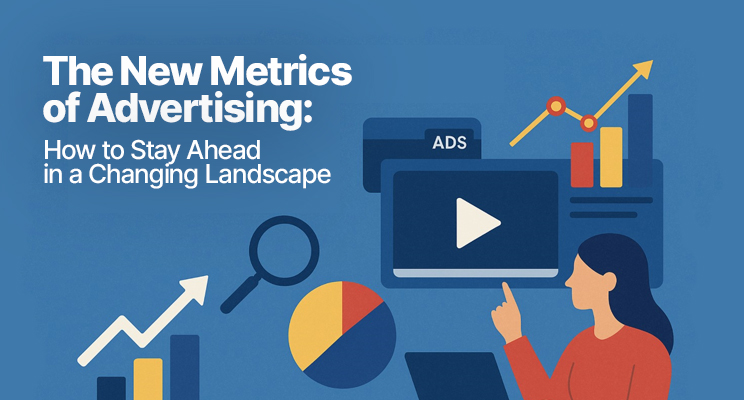
The advertising industry is undergoing an unprecedented transformation, with new technologies, shifting consumer behaviors, and evolving market dynamics fundamentally changing the game. To stay relevant, brands must innovate in their campaigns and rethink how they measure success.
In this article, we explore the top advertising trends in 2025—and how marketers can align their measurement practices to stay competitive.
“Too often, brands are still measuring success by outdated metrics. In 2025, what matters is not how much attention you buy—but how much impact you generate. At RSB, we help brands redefine what success looks like.” – Natalie Hunter, Chief Business Officer, RSB Insights & Analytics
- AI-Generated Advertising: Generative AI Transforms Ad Creation Generative AI is revolutionizing content creation by enabling quick, inexpensive ad creation. While this allows brands to publish more creative assets at a lower production cost, it increases the risk of wasteful media spend on potentially ineffective ads.
To match the speed of production, AI-powered ad measurement and optimization tools are essential. These tools not only enable marketers to analyze performance at scale but also optimize ads in real time, helping to reduce inefficiencies and maximize return on ad spend (ROAS). - AI-Driven Personalized Ads: Hyper-Personalization Boosts Engagement—But Requires Caution The ability to create hyper-personalized ads tailored to individual preferences using tools like ChatGPT and DALLE is transforming advertising .Predictive analytics allow marketers to anticipate consumer needs before they arise.
This level of customization has the potential to enhance engagement and drive better results. While hyper-personalization drives engagement, excessive targeting can lead to ad fatigue and may even alienate audiences if not carefully managed. - Multi-Platform Campaigns: Seamless Cross-Device Messaging Is Key Consumers navigate seamlessly between devices—smartphones, desktops, and smart TVs – consuming streaming content across platforms. This shift makes multi-screen messaging essential, not optional.
Earlier metrics, such as clicks and impressions, no longer provide a complete or accurate picture of campaign success. They often fail to measure whether an ad truly captures and retains attention or resonates with audiences on a deeper level.
Instead, brands should:
- Use neuro tools—such as facial coding and eye tracking—that capture pre-system 1 responses to more accurately gauge true sentiment and preference. This ensures messaging is synergistic across platforms and maximizes impact.Brands that integrate messaging across touchpoints create cohesive experiences that increase relevance and reduce acquisition costs.
- Evaluate performance holistically across channels to recognize the contribution of each touchpoint and determine the optimal digital footprint to maximize the impact of and return on future campaigns.
Avoiding the trap of recycling ads across platforms is crucial. Successful content is designed for the native style of each platform, utilizing its strengths and appearing authentic. To achieve this, evaluate each ad within its specific context.
- Use neuro tools—such as facial coding and eye tracking—that capture pre-system 1 responses to more accurately gauge true sentiment and preference. This ensures messaging is synergistic across platforms and maximizes impact.Brands that integrate messaging across touchpoints create cohesive experiences that increase relevance and reduce acquisition costs.
- Virtual Influencers and AI Creators: Redefining Engagement: Influencers have shaped social media marketing for years, but AI-powered virtual personalities are offering brands a new, more controlled way to engage audiences, ensuring consistency and lower risks compared to human influencers. Whether working with human or AI-generated influencers, advertisers must assess their success and contribution to the campaign. This evaluation is just as critical as analyzing other advertising efforts to ensure resources and budgets are used effectively.
- Privacy-First Marketing: Contextual Advertising Grows with Privacy Regulations: Marketers are increasingly adopting privacy-focused strategies to comply with stricter global privacy regulations. Contextual advertising, which aligns ads with the content being consumed instead of relying on personal data,
This approach helps balance relevance with privacy. To accurately measure its impact:
- Consider how the surrounding content affects ad performance.
Analyze engagement within specific contextual environments to gain deeper insights.Key Takeaway for Advertisers: Creativity and data-driven insights ensure success.
As the advertising ecosystem becomes more complex, brands must innovate not just in their campaigns but also in their measurement techniques. Embracing advanced ad measurement models is crucial to ensure creativity and impact in today’s fast-evolving landscape.
Success will depend on balancing human creativity with data-driven insights, ensuring every campaign not only reaches its audience but also resonates meaningfully.
At RSB, we specialize in helping brands navigate these dynamic advertising changes, using cutting-edge AI tools and data-driven insights to ensure your campaigns not only succeed but thrive in 2025 and beyond.
Ready to redefine success in your advertising?
Discover how RSB Insights can help you measure what truly matters.
Contact Natalie Hunter at natalie@rsbinsights.com to learn more.


